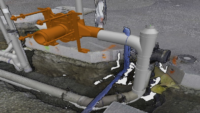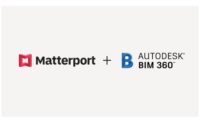
When it comes to setting wall points, geospatial accuracy and layout efficiency go hand in hand-even in buildings that have uncomplicated interior wall designs. Keith Giddens, director of virtual design and construction for wall and ceiling contractor BakerTriangle, can attest to that. The contractor is constructing interior walls on the first and third floors of a four-level podium to be used for exams and treatments comprising more than a million square feet in a large hospital in Dallas. Even though the walls are straight, they are very lengthy: one corridor is 520 feet long. Layout mistakes tend to multiply in such a situation. Giddens and BakerTriangle are fully immersed in the building information modeling process on this project and other ones in their portfolio. In mid-2010, the company invested in some high-tech software and site tools that bring precision to wall layout and began using them on this contract in spring 2011. The tools include a Sokkia SRX-3 robotic total station and RC-PR4 Controller and 3-D GTP CAD software and a patent-pending X-Y positioning unit from Get the Point, LLC, a Larkspur, Colo.-based Sokkia dealer. Get the Point is also a software development company specializing in utilities that work within AutoCAD, Revit and Navisworks to allow automated point placement within these programs.

According to Giddens, the real value of the tools is improved accuracy, which saves time in the long run by eliminating ever-so-slight variances from architectural drawings that might cause future problems in locating nearby structures or utilities-or, in a worst-case scenario, tear-outs of structures or equipment. “The benefit you get out of [the tools] is that you know the points are right,” says Giddens. In late summer 2011, Preston Pressley, an estimator for BakerTriangle, worked within the model, applying layout points to the third level of the podium using the Get the Point software. The intersections of column offset lines revealed the positions of control points for Baker Triangle that were to be used to position the robot. The general contractor mounted self-leveling lasers over several of these control points located on the first level, which transferred control vertically throughout the podium levels. This vertical control established accuracy as the layout moved continuously up the building. BakerTriangle can utilize total stations for layout because the company uses coordinated CAD drawings. The GTP software automates the labeling of points with unique point numbers within the model. Not only is field layout more efficient, but annotation time is also greatly reduced. Prior to the availability of the GTP software, annotation of serpentine walls would have been a major challenge. The data, including points with background information, are exported from the software to a data collector. The process of providing field personnel with a drawing, then, becomes an electronic file transfer.

Giddens notes that, although the corridor walls on the podium levels are straight-albeit long-they have numerous openings for doors and other structures. The file that foreman and layout specialist Edmundo Piedra used for shooting points was fully annotated, giving BakerTriangle a great deal of self-sufficiency. Instances in which BakerTriangle must ask the architect via the general contractor about a dimension or structure on a drawing have become rare because the points have been imported into the CAD file prior to being physically marked within the structure. “All of that information is in there right in front of [Piedra]-he doesn’t have to go back through the plan and flip through openings to try and find the dimensions,” says Giddens. On one wall location with a recess for a door, adds Pressley, “We put in the two different types of elevations and the width so he doesn’t have to flip through drawings.”
BakerTriangle is finding the GTP software useful on another current project in Dallas. The Museum of Nature & Science features some walls and ceilings which, Giddens contends, are so intricate that he cannot imagine laying them out without the use of the program.
“That shows you how versatile [the program] is,” Pressley says. “We’re using it out here and the level of detail is not as tedious, but we’ve got miles of wall. We’re also using it three miles up the road for a project that isn’t even half the size, but the level of difficulty there is so extreme. We’re using it to be dead-on because the degree of difficulty is so much higher.”
To make detailing wall framing even easier, Giddens and BakerTriangle are utilizing Metal Wood Framer by StrucSoft. The wood and light gauge metal wall framing add-on program runs on the Revit platform and recognizes Revit walls, doors, windows, and openings and automatically generates stud arrangements.
BIM AND EFFICIENCY
BakerTriangle’s adoption of these tools allows the contractor to get involved in BIM and allows each individual to work more independently. The need to wait for someone else to provide information or complete a task is vastly reduced.
“You get a lot more problems solved up front before it gets to the field, and that’s what it’s all about,” Giddens says. “Before we were involved in BIM, we ran into a lot more problems in the field and we’d have to stop. We’d have to turn the problem in and wait for an answer and maybe have somebody tear something out to let us do our work.” Before BIM, a duct contractor might see a straight wall and run straight duct but miss an offset. Now, the offset is marked for the duct contractor. Involving a drywall/ceiling contractor in the third modeling process is relatively new, Giddens points out. “If we’ve got bracing on our walls, [the other trades] can work around it-it’s all preplanning, really.
“On a project that’s coordinated properly, everybody knows what they’re up against. Schedules get worked out early and everybody knows when they can start work and what they’re supposed to get done. It eliminates a lot of what we used to run into in the field where we’d have to stop and wait for somebody to make a decision. It’s all sequenced and planned and everything’s ready to go. It does run a lot more smoothly when everything is coordinated.”
Previously, BakerTriangle provided its layout personnel with printouts from digital takeoff and estimating software that included labels and color coding. A great deal of manual addition and subtraction was necessary when marking points and wall radii and angles often caused errors in the field. In some cases, a dimension would be excluded on an architectural drawing and work would stop while a Request for Information was sent to the architect via the general contractor.
“This way, it’s directly off of the CAD file, where they drew it,” says Giddens. “It takes out a lot of that error of guys trying to do the math.”
Pressley adds, “[Piedra], the guy doing our layout, contacted me about issues where several door and window location dimensions were not provided in the architectural drawings. He’ll write down a list of those locations and I can simply go into AutoCAD and pull those dimensions for him and have a printout within minutes-it’s as easy as that. We don’t have to send RFIs to the architect and wait for their response-it’s instant.”
Using the robotic total station often clears up differences among trades, according to Giddens. The instrument allows BakerTriangle to ensure that intersecting lines are square and verify some dimensions before points are marked. Accomplishing this, as well as the mere fact that BakerTriangle uses the instrument, provides other contractors with a comfort level and resolves many disputes before they even arise, Giddens contends.
The high-precision tools can even make the architect’s job easier, Giddens says. “I had one architect ask me a while back when he could stop dimensioning drawings. I told him that with us, you can start right now.” He said that he can envision the adoption of the tools impacting general contractors’ selection of wall subcontractors in the future.

Out on the third floor of the podium, Piedra leveled the total station, which was set over a control point 3 feet off of the column line. The total station sent a laser beam to a 360-degree prism mounted on a pole several feet away for backsight and the beam reflected off of the prism, orienting the total station within the building by triangulating its position. Also mounted on the same pole was a Juniper Systems Mesa Rugged Notepad containing a file of a drawing with X, Y and Z positions for all of the wall layout points on the third level.
The total station communicated via Bluetooth to the notepad. The data in the notepad from the BIM file indicated to Piedra where he was to set the pole, the top of which also held the RC-PR4 Controller. Guided by the data in the handheld unit, the RC-PR4 pinpointed the location of a layout point based on the information from the BIM file. Piedra set down the pole, upon which an X-Y Positioner-a patent-pending device designed specifically to expedite the wall layout process-was mounted. The X-Y Positioner used its self-leveling laser to shoot out a red laser beam indicating on the floor the exact location of the first point for the wall corridor, and Piedra marked the point with a grease pencil.
The X-Y Positioner makes wall layout particularly efficient because it quickly and automatically plumbs the center location of the prism. “The X-Y Positioner is really what allows us to use this equipment for wall layout because it’s accurate and fast,” said Giddens. “Under the old way of doing it, you’d move the pole to about where it’s supposed to be and you’d level it back up and that takes a little time. Then the notepad would tell you to move back half an inch and right a quarter-inch. If you’re hanging duct strap or all thread for piping that is going to be concealed above the ceiling, that’s close enough. But for walls, when you shoot that point in, it has got to be right on. Now you’ve got to plumb the thing right back up. That process would actually take way more time than it did with tape measures and chalk.”

Piedra got comfortable with the technology over several months. “It continues to go faster and faster,” he said, adding that the self-leveling laser on the X-Y Positioner substantially increases the efficiency of wall layout.
Giddens and Pressley indicated that using these high-precision tools should increase the stature of BakerTriangle and possibly even help to bring in more work in the future.
Recalling one project pre-planning meeting in which the building team viewed the 3-D model from various locations across the country, Giddens says, “With this technology, we’re able to ‘build’ stuff before it’s actually built, figure out problems and find better ways to do things. We’re able to build virtual mock-ups, including window openings and flashing details. When we’re working within a system, all of that can be coordinated.”
Pressley concludes that some bid packages are requiring the use of BIM. “I would assume that most mechanical, electrical and plumbing contractors in town have BIM down, but as far as we’re concerned, not all wall contractors are up to speed, so when we see that requirement in a bid package, that’s going to eliminate some competitors right off the bat.”




Report Abusive Comment